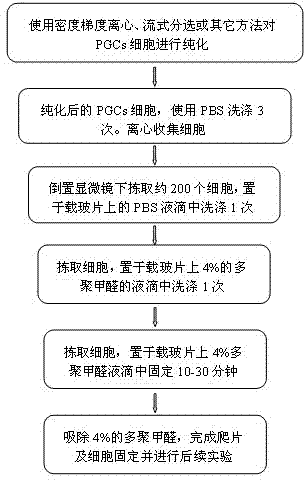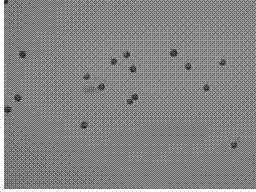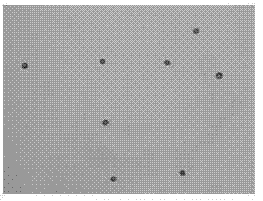Slide climbing method of PGCs (primordial germ cells)
A technology of primordial germ cells and slices, which is applied in the biological field, can solve time-consuming and labor-intensive problems, and achieve the effects of saving time, related expenses, and cost
- Summary
- Abstract
- Description
- Claims
- Application Information
AI Technical Summary
Problems solved by technology
Method used
Image
Examples
Embodiment 1
[0028] Embodiment 1: a kind of climbing method of primordial germ cells (such as figure 1 shown)
[0029] 1) Primordial germ cells are purified by Nycodenz density gradient centrifugation, Percoll density gradient centrifugation or flow sorting;
[0030] 2) Wash the purified primordial germ cells 3 times with PBS, and collect the cells by centrifugation at 200 g for 5 minutes;
[0031] 3) Pick 100-200 cells under a microscope and wash them once in PBS droplets on a glass slide;
[0032] 4) Pick the cells and wash once in a 4% paraformaldehyde solution;
[0033] 5) Pick the cells and fix them in 4% paraformaldehyde droplets on the slide for 10-30 minutes;
[0034] 6) Absorb the paraformaldehyde with a concentration of 4%, and complete the climbing and fixing of PGCs cells.
[0035]
Embodiment 2
[0036] Example 2: AKP (alkaline phosphatase) staining of PGCs cells:
[0037] According to Example 1, slice and fix the PGCs cells, remove the 4% paraformaldehyde solution, wash 3 times with 200 μL PBS, 5 minutes each time; add BCIP / NBT staining solution, and incubate in a humid environment at room temperature for 1 h; wash After slicing, observe and take pictures under an inverted microscope.
[0038] Such as figure 2 As shown, because PGCs cells are rich in alkaline phosphatase, the stained PGCs cells appear blue.
[0039]
Embodiment 3
[0040] Example 3: PAS (alkaline phosphatase) staining of PGCs cells:
[0041] Slice and fix PGCs cells according to Example 1, remove 4% paraformaldehyde solution, wash 3 times with 200 μL PBS, 5 minutes each time; add Periodic Acid Solution, incubate at room temperature for 5 minutes; add Schifff's Reagent, incubate at room temperature for 15 minutes , After washing, observe under an inverted microscope and take pictures.
[0042] Such as image 3 As shown, because PGCs cells contain a lot of glycogen, they are red after PAS staining.
[0043]
PUM
 Login to View More
Login to View More Abstract
Description
Claims
Application Information
 Login to View More
Login to View More - R&D
- Intellectual Property
- Life Sciences
- Materials
- Tech Scout
- Unparalleled Data Quality
- Higher Quality Content
- 60% Fewer Hallucinations
Browse by: Latest US Patents, China's latest patents, Technical Efficacy Thesaurus, Application Domain, Technology Topic, Popular Technical Reports.
© 2025 PatSnap. All rights reserved.Legal|Privacy policy|Modern Slavery Act Transparency Statement|Sitemap|About US| Contact US: help@patsnap.com



